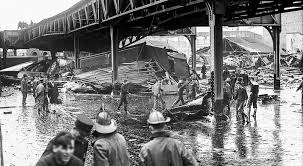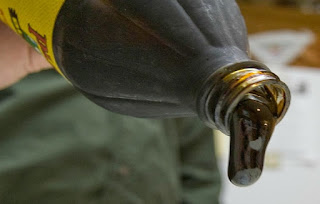nPosted on January 15, 2018
n
n
n
n
n
n
nOn this date in 1919, a wave of molasses rushed through a neighborhood of Boston at about 35 miles per hour!
n
n
n
nToday’s historical anniversary is unexpected – and it certainly lends itself to puns like “It was a sticky situation!” – and both of these things make it seem kind of funny.
n
n
n
nBut it was a disaster. And a lot of people were hurt. And some people died! It was definitely NOT funny.
n
n
n
nWhat was the Great Molasses Flood?
n
n
n
n The Purity Distilling Company had a factory in the North End neighborhood of Boston, Massachusetts. It had a really large storage tank that held about 2,300,000 U.S. gallons of molasses. The tank was about 50 feet (15 m) tall and 90 feet (27 m) in diameter.
The Purity Distilling Company had a factory in the North End neighborhood of Boston, Massachusetts. It had a really large storage tank that held about 2,300,000 U.S. gallons of molasses. The tank was about 50 feet (15 m) tall and 90 feet (27 m) in diameter.
 The Purity Distilling Company had a factory in the North End neighborhood of Boston, Massachusetts. It had a really large storage tank that held about 2,300,000 U.S. gallons of molasses. The tank was about 50 feet (15 m) tall and 90 feet (27 m) in diameter.
The Purity Distilling Company had a factory in the North End neighborhood of Boston, Massachusetts. It had a really large storage tank that held about 2,300,000 U.S. gallons of molasses. The tank was about 50 feet (15 m) tall and 90 feet (27 m) in diameter.n
n
n
nAnd “was” is a really good word to use here, because the molasses tank – just collapsed!
n
n
n
nWitnesses must’ve thought it was an earthquake, at first, because they felt the ground shake and heard a long roaring rumbling sound. But then there was a huge crashing sound, a sort of thunderclap, followed by a machine-gun-like sound. The latter was the sound of the rivets shooting out of the collapsed tank.
n
n
n
n The molasses created a wave 25 feet (8 m) high! It damaged the girders of the elevated railway, tipped a railroad car sideways for a moment, and swept away and crushed several buildings. A truck was picked up and swept into the harbor.
The molasses created a wave 25 feet (8 m) high! It damaged the girders of the elevated railway, tipped a railroad car sideways for a moment, and swept away and crushed several buildings. A truck was picked up and swept into the harbor.
 The molasses created a wave 25 feet (8 m) high! It damaged the girders of the elevated railway, tipped a railroad car sideways for a moment, and swept away and crushed several buildings. A truck was picked up and swept into the harbor.
The molasses created a wave 25 feet (8 m) high! It damaged the girders of the elevated railway, tipped a railroad car sideways for a moment, and swept away and crushed several buildings. A truck was picked up and swept into the harbor. n
n
n
n
n
n
nWhen the molasses slowed, an area of several square blocks was flooded two to three feet deep, and uninjured people kept wading into the sticky mess to pull out those that were injured.
n
n
n
n The first responders were cadets from the Massachusetts Nautical School; they were soon joined by police, Red Cross, Army, and other Navy personnel. They worked for four days to search for and rescue victims, using a non-crushed building as a sort of makeshift hospital.
The first responders were cadets from the Massachusetts Nautical School; they were soon joined by police, Red Cross, Army, and other Navy personnel. They worked for four days to search for and rescue victims, using a non-crushed building as a sort of makeshift hospital.
 The first responders were cadets from the Massachusetts Nautical School; they were soon joined by police, Red Cross, Army, and other Navy personnel. They worked for four days to search for and rescue victims, using a non-crushed building as a sort of makeshift hospital.
The first responders were cadets from the Massachusetts Nautical School; they were soon joined by police, Red Cross, Army, and other Navy personnel. They worked for four days to search for and rescue victims, using a non-crushed building as a sort of makeshift hospital. n
n
n
nWhen all was said and done, about 150 people and many dogs and horses were injured, and 21 people and several horses were killed.
n
n
n
nCleaning up the property damage took even longer. A fireboat was used to spray salt water onto the molasses, and workers shoveled sand over molasses to try to absorb the stuff that didn’t immediately wash away.
n
n
n
nAnd when I say “wash away,” where do you think “away” was? The Boston Harbor was brown because of molasses the rest of the winter, all spring, finally dissipating in the summer.
n
n
n Of course, not all of the molasses was washed into the harbor. All those rescue workers, cleanup crews, and sight-seers inevitably tracked molasses out of the disaster zone, into nearby streets, onto public transportation, and pretty much all over Boston. Everything from subway platforms to seats in trains and streetcars, from pay telephone handsets to doorknobs in homes – for a long time, almost everything was sticky.
Of course, not all of the molasses was washed into the harbor. All those rescue workers, cleanup crews, and sight-seers inevitably tracked molasses out of the disaster zone, into nearby streets, onto public transportation, and pretty much all over Boston. Everything from subway platforms to seats in trains and streetcars, from pay telephone handsets to doorknobs in homes – for a long time, almost everything was sticky.
 Of course, not all of the molasses was washed into the harbor. All those rescue workers, cleanup crews, and sight-seers inevitably tracked molasses out of the disaster zone, into nearby streets, onto public transportation, and pretty much all over Boston. Everything from subway platforms to seats in trains and streetcars, from pay telephone handsets to doorknobs in homes – for a long time, almost everything was sticky.
Of course, not all of the molasses was washed into the harbor. All those rescue workers, cleanup crews, and sight-seers inevitably tracked molasses out of the disaster zone, into nearby streets, onto public transportation, and pretty much all over Boston. Everything from subway platforms to seats in trains and streetcars, from pay telephone handsets to doorknobs in homes – for a long time, almost everything was sticky.
Bostonians claimed that, even decades later, on hot summer days the Boston neighborhood smelled like molasses!
n
n
n
n
nI found it interesting that, even the past few years, people have studied this disaster to learn from it. In 2014 a study was published with a modern engineering analysis of why the storage tank collapsed, and in 2016 a team of students at Harvard University collected data from the historic disaster, building a scale model of the affected neighborhood, and studying the behavior of cold corn syrup on the scale model.
n
n
n
n
n
n
n
n
n
n
n
nAlso on this date:
n
n
n
n
n
n
n
n
n
n
n
n
n
n
n
n
n
n
n
n
n
n
n
n
n
n
nWikipedia’s birthday
n
n
n
n
n
n
n
n
n
n
n
n
n
n
n
n
nAnniversary of the first solar-heated house in the U.S.
n
n
n
n
n
n
n
n
n
n
n
n
n
n
n
n
n
n
n
n
n
n
n
n
n
n
n
n
n
n
n
n
n
n
n
n
n
n
n
n
n
n
n
nFiesta del Nino Perdido in Peru
n
n
n
n
n
n
n
n
n
n
nNational Day of Service
n
n
n
n
n
n
n
n
n
n
n
n
n
n
n
n
n
n
nPlan ahead:
n
n
n
nCheck out my Pinterest pages on:
n
- n
-
n
-
nJanuary birthdays
n
-
n
n
n
n
n
nAnd here are my Pinterest boards for:
n
- n
-
n
-
n
-
n
n
n
n
n
n
n












